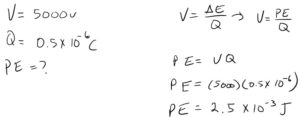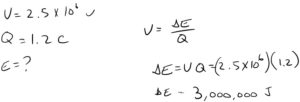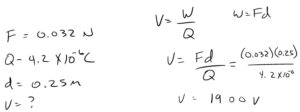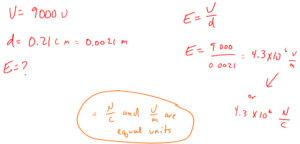Potential Difference or Voltage
Potential difference (or electrical potential) is work done as a single charge is moved in an electric field. When work is done on this charge there is potential energy stored in that charge to flow. Potential difference is measured in volts and commonly called voltage (V). Voltage related to the potential for a single charge to flow. The bigger the voltage the more desire to flow.
Potential Difference Basics
- The variable (V) is used for potential difference, also called voltage
- The unit for potential difference is the volt (V)
- The unit volt describes the potential difference and 1 V equals 1 J/C or 1 Joule of work per Coulomb of charge
| Potential Difference Variables | |||
| Name | Variable | MKS Unit | Unit Abbreviation |
| Potential Difference or Voltage | V | Voltage | V |
| Work | W | Joule | J |
| Potential Energy | PE | Joule | J |
| Charge | q | Coulomb | C |
| Distance | d | Meter | m |
Potential Energy vs. Potential Difference
Electrical potential energy is related to potential difference.
Both are created when you have an area with more electrons and a second area with less. The greater the difference between those charges, the greater both the potential energy and potential difference. Once you give those charges a conductive path from a high density of electrons to a lower there would be current or flow. The flow or current, would occur from the area of many electron to the area that has less. This would occur until there was no longer an "electrical pressure" caused by a difference in charge.
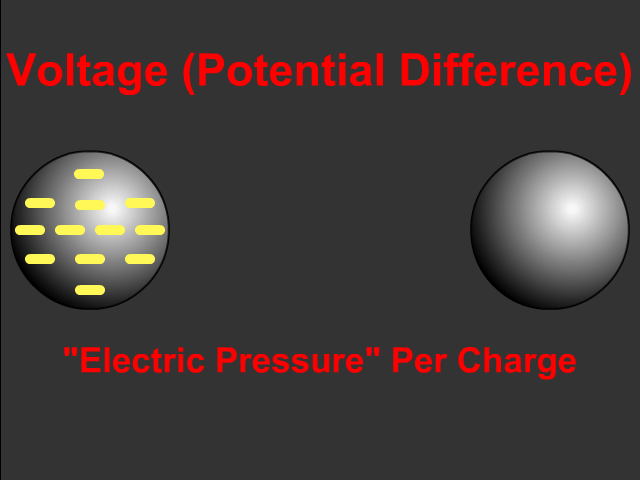
So how is electrical potential energy different than potential difference?
Electric potential energy is an overall pressure, or potential, caused by "all" the charge and overall potential to flow. The key here is all the charge. Electrical potential energy is equal to the work that can be done by the flow. The amount of energy or work that could be done has the unit Joule (J).
Potential difference is a pressure, or potential, from a "single" charge to flow from the area of many electrons to the other with a few. Therefore the unit volt (V) for potential difference is describing something different. The key to potential difference, also called voltage, is that it is a per charge value.
- Electrical Potential Energy: The Entire Charge
- Potential Difference or Voltage: A Single Charge
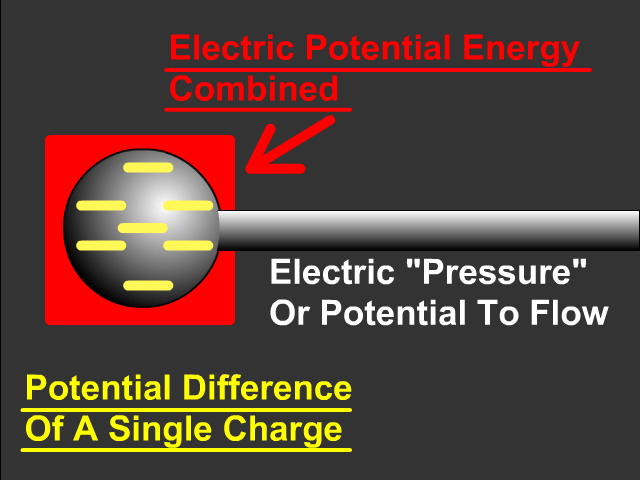
The three equations below relate variables to the potential difference (V). The variables and units for these are also below.

Variable: Name (unit)
V : Potential difference (voltage) (V)
W : Work (J)
q : Charge (C)
PE : Potential Energy (J)
d : distance (m)
Example Problems
1. A balloon receives 5000 V when it is rubbed on your head and acquires a charge of 0.5 x 10-6 C. What is the total PE of the electrons on the balloon’s surface?
2. If 24 J of work is done to push 0.0033 C of charge into an electric field, what will the voltage of the charge be?
3. A bolt of lightning is caused by a voltage of 2.5 x 106 V. If it transfers 1.2 C of electric charge to the ground, how much energy does the bolt contain?
4. A force of 0.032 N is required to move a charge of 4.2 x 10-6 C in an electric field between two points that are 25 cm apart. What is the potential difference between the points?
5. A spark will jump when there is a potential difference of 9000 V between the door and the palm of your hand. If this happens at a distance of 0.21 cm from your hand, what is the electric field between your hand and the door?
Links
- On to practice problems on our Electrostatics Review Page
- Back to the Electrostatics Main Page
- Back to the Stickman Physics Home Page
- Equation Sheet

